The popular (hi)story of furniture design is, no-one could argue, a very male (hi)story.1
Which doesn't mean that furniture design is a profession at which males excel more than females, a profession for which males have a natural affinity above and beyond that of females, that females' natural domains are textiles and colours; much more is because that popular (hi)story of furniture design contains flaws, biases, inaccuracies and under-illuminated corners.
A great many of which can be traced back to those institutions charged with recording, documenting and mediating the (hi)story of furniture design, who are responsible for nurturing and validating the popular narrative of the (hi)story of furniture design.
With the project Spot On: Women Designers in the Collection the Vitra Design Museum Schaudepot shine a critical spotlight into some of the under-illuminated corners of their own collection.......
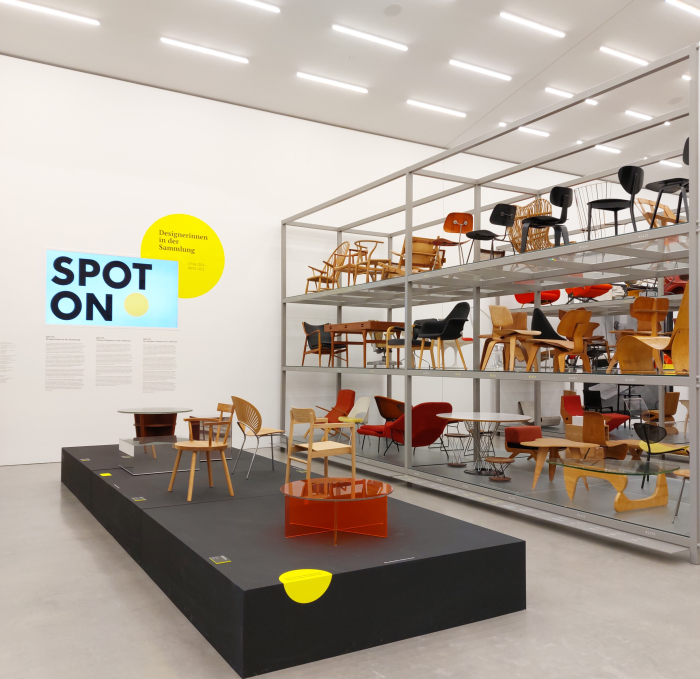
Opened in 2016 as a home and exhibition space for the Vitra Design Museum's collection, the Vitra Design Museum Schaudepot features alongside its permanent exhibition regular thematic showcases employing items from its collection, and which allow for differing perspectives on the collection and/or a deeper explorations of selected themes; temporary showcases which over the years have included the likes of, and amongst many others, Gae Aulenti: A Creative Universe, Living in a Box. Design and Comics or Anton Lorenz: From Avant-Garde to Industry.
In 2021 the Vitra Design Museum Schaudepot turned 5 and, presumably, because it therefore had developed a longer concentration span, wasn't in so much need of constant fresh stimulation, the thematic showcases were extended from their previous ca. four month runs to whole year runs, and became projects as much as showcases; the first annual project/theme being Spot On: Women Designers in the Collection, a project involving a critical re-appraisal of museum's collection and physically represented by both a re-organisation of the Schaudepot permanent exhibition to include more works by more female designers, and a continuation of the island presentation format of previous showcases to highlight specific works and specific creatives.
The latter including the island of Guest Curator on which the Indian architect Khushnu Panthaki introduces a lounge chair by Gunjan Gupta, a work crafted from everyday objects found in India and which represents an expression of Gupta's reflections on an "Indian chair", Gupta's reflections on seating, sitting, Indian society, Indian culture, India; a work crafted from everyday objects that is also an expression of Jugaad, a term found in several of the languages of India for improvising a solution, for making do with that which one has, a process and mentality comparable with the Brazilian concept of Gambiarra, and which thus further reminds us all that design is a way of approaching problems as much as a monetisable profession. And a work crafted from everyday objects by an Indian creative in a European design museum that is anything but an everyday occurrence: a work in a European design museum by a European creative inspired by India but developed in context of European societies/norms, yes; a work in a European design museum by an Indian creative exploring Indian culture and society past and present from an Indian perspective..... no.
And which thus helps underscore that gender (im)balance is but one of the problems in the popular (hi)story of furniture design.
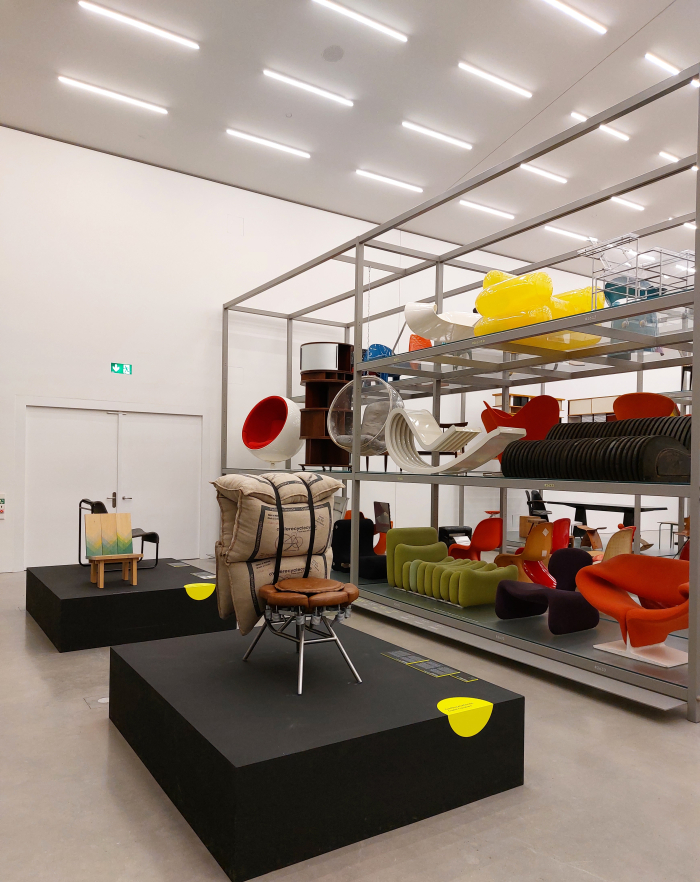
A short sail from the island of Guest Curator stands the island of Newcomer on which one finds Neil by Lisa Ertel and Anne-Sophie Oberkrome, a work we first saw in context of our 2018 #campustour at the Hochschule für Gestaltung, Karlsruhe, a work which arose in context of a semester project sponsored by Magis, and of which we in 2018 opined represented for us the "the most sumptuous, and satisfyingly uncomplicated, moulded plywood chair", was a work which "tried to tell you it’s from the 1970s, but which all logic tells you can’t be", which it still is and still does and a work which is still an utter joy. And a work we're horrified to see is still without a producer. How can that be! No honestly, how!! A horror magnified when we consider all the other joyous moments our #campustour gave us over the years when such was possible, advisable, and joyous moments which today reside but in memory and not en-masse in domestic and commercial spaces.
The fact however that an institution such as the Vitra Design Museum saw fit to acquire Neil, helping underscore the important role design museums play in the documenting and charting of design; that in the variety and scope of objects they purchase a design museum collection is a more reliable, more probable, more meaningful source of information on design contemporary and design historical than commercial manufacturers portfolios, contemporary and historical, which tend to be based more on what they believe will sell rather than what is considered interesting, relevant and challenging.2 Or design museum collections should be, certainly can be, more reliable, more probable, more meaningful, if the collection policy is structured in such a manner as to allow objects to be collected independent of the personal predilections of the responsible curators. And unsullied by ingrained institutional and professional practice prejudices, unsullied by unquestioned established methodology. Which, arguably, European design museum collection policies haven't always been.
Thus a work such as Neil helps underscore how that which museums collected in the past informs our contemporary understandings of furniture design (hi)story, including understandings of the male:female balance; helps underscore why that which museums collect in the now is important in how coming generations will understand the (hi)story of furniture design, will be the basis of future generations' understandings of the (hi)story of design; and also helps underscore why what museums display and don't display from their collections is important in validating popular understandings of that (hi)story of furniture design.
Something reinforced a little further down the archipelago on the island of Hidden Stories.
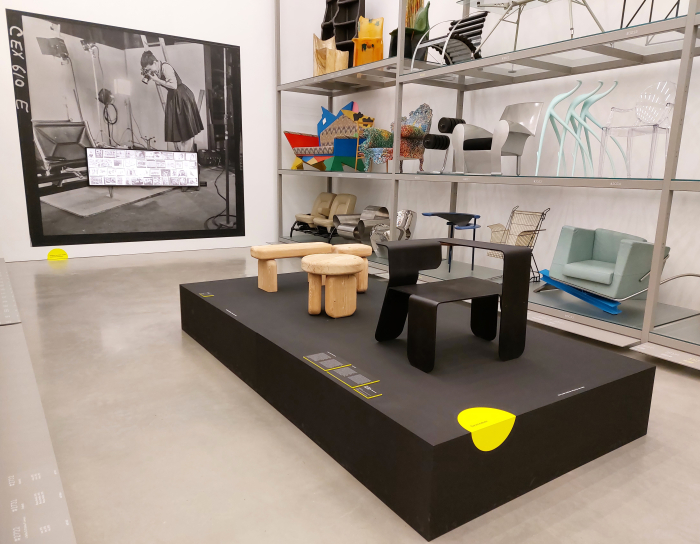
For all the many popularly known delights furniture design has brought forth, just as important in the development of furniture design are the innumerable popularly unknown delights; works such as a ca. 1951 tubular steel chair by Maija-Liisa Komulainen, a work in which the tubular steel is so folded, and we deliberately use the word folded rather than bent, there is very much an origami thing going on, the tubular steel is so folded that seat and backrest are not directly joined rather exist interdependent of one another at either ends of the steel tubes, a construction principle which, one presumes, we didn't get to try it, bequeaths the chair its cantilever-esque resilience. And enables a resilient backrest that moves with the sitter.
A work with a charm and grace and honesty and composure which mean it could be released tomorrow and be a fresh and joyous addition to the global furniture community. Would be one of the more meaningful new chair releases in recent years.
A work of which the curators note "shows clear influences of US mid-century design", which we'd question; for us as a work it's silhouette is very much reminiscent of a pared-down, tubular steel version of the Aalto Paimio Chair3, while conceptually it is very reminiscent of 1930s works by the Italian architect Giuseppe Terragni who employed the same principle, as can be viewed elsewhere in the Schaudepot in one of Terragni's Lariana chairs, the key difference being that the textile seat and backrest bequeath Komulainen's chair a much softer, less harsh character than Terragni's, make it more an informal lounge chair than a formal dining or lobby chair, and thus, for us, a component of the humanising of Modernism, humanising of the more dogmatic aspects of Functionalism, that was at the heart of the work of, for example, Komulainen's fellow Finns Alvar and Aino Aalto. And yes, also US mid-century, but which the Finns were doing long before mid-century, and long before the Americans cottoned on.
And a work of which the curators further note "has been in the collection for many years but research is still ongoing". Whereby we don't imagine for minute that the Vitra Design Museum curators have been dragging their heels, much more, we suspect, we haven't asked, we just suspect from our own experiences, that the available archive information on the work is at best sparse. Another source of problems in the development of our understandings of the (hi)story of furniture design, for all in context of females who (hi)story hasn't always recorded as fulsomely, accurately and equitably as males. Yet while the Vitra Design Museum can do little where independently verifiable information is not available, the fact that despite having been in the museums possession "for many years" it, as far as we are aware, and understand the context of its presentation in Spot On, has never been shown before, and that despite being highly communicative object which invites one to interact with it, positively demands an exchange of ideas, highlighting that while a museum can never show all its collection, that which it does show, that which is actively selected for presentation, informs popular understandings. That which isn't shown isn't part of the discourse.
And if museums show more works by men than by women.....
Which is why it is important that design museums not only reflect critically on their collection and acquisition policies, but develop exhibiting strategies that, as best possible, avoid the pitfalls of prejudice, tradition or groupthink.
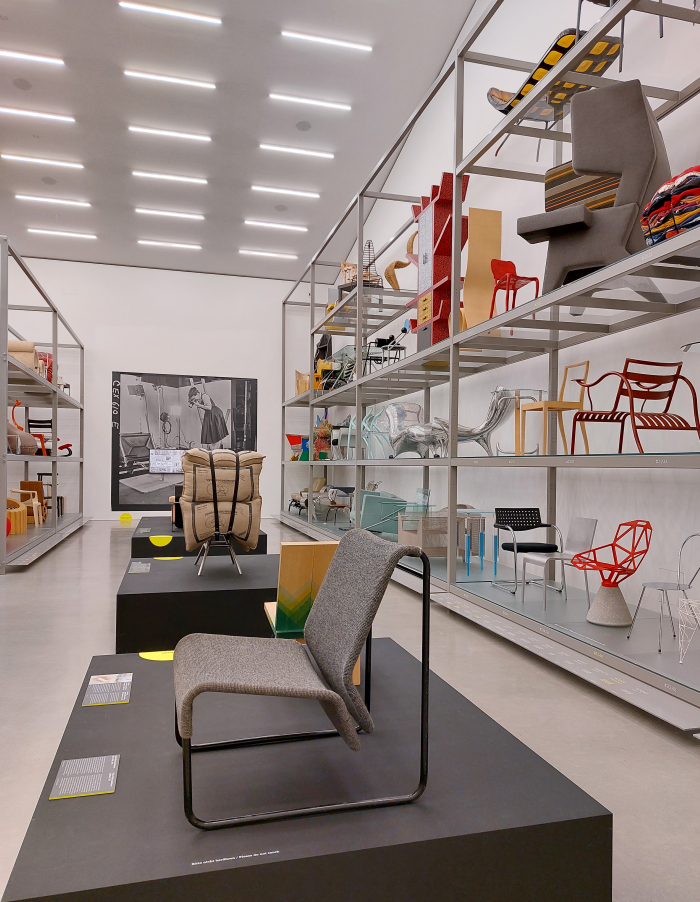
Although very much a stand alone presentation in its own right, Spot On achieves a new dimension as an extension of the exhibition Here We Are! Women in Design 1900 – Today in the Vitra Design Museum's Gehry Building: while Here We Are! explores the whys and hows of the popular (his)story of the (hi)story of furniture design, is as much a sociological study and cultural history study as a design study, Spot On, in placing largely popularly unknown works by female designers alongside largely popularly known works by male designers, not only helps many female creatives to retake their place on design's helix, but also tangibly illustrates just how skewed much of our understandings of the (hi)story of furniture design is.
Something Spot On can do particularly well on account of the Schaudepot's chronological progression, a progression which although reflective of the various popularly understood epochs of furniture design, also helps explain it isn't that simple. And while there is still a notable lack of females in the presentation's opening decades, those at the turn of the 19th/20th centuries, and thus an indication of a potential collecting focus in coming years, for there are interesting female designers to be located in those decades, the increase of female designers in later decades, the increased visibility of female designers in, for example 1980s Postmodernism or 21st century design beyond the commercial, achieved by the conscious, and painless, re-organisation does bring a new character to the chronology, to the ongoing developments that compose the (hi)story of furniture design.
¿And is something that could have been undertaken earlier?
¿Something that didn't need an extra effort?
¿Something that shouldn't have needed a special project?
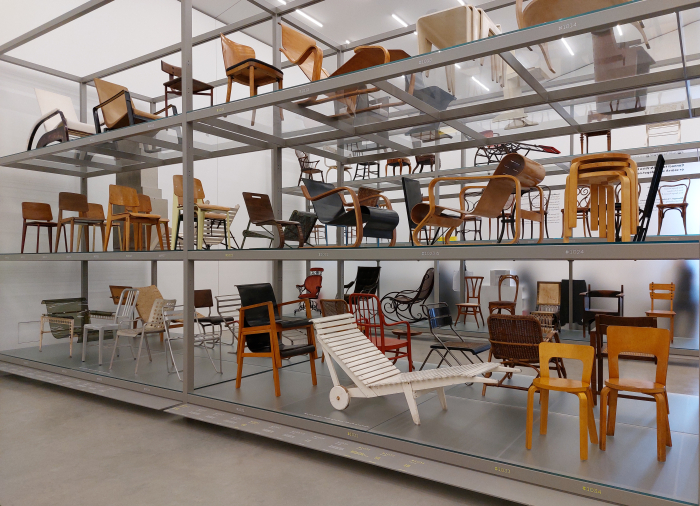
Yes.
But also in many regards, no.
As we noted from Here We Are! for a long time everyone was absolutely certain that we knew absolutely everything about the (hi)story of furniture design, until such time as we all scratched the surface and it became patently obvious that that which was accepted as being everything couldn't possibly have been. Including the assumptions that were generally followed as to the gender balance; over a great many decades furniture design was popularly, and blithely, accepted as a male profession. As were so many other professions and aspects of life and society.
The changes in perspective which enabled the appreciation of the errors of our ways, which forced us all to accept the errors of our ways, being, as Here We Are! discusses, related to wider discourses and developments in societies and culture. Yes the changes could have happened much quicker, but are now underway, we are, as Vera Sacchetti and Matylda Krzykowski demanded from the Kunstgewerbemuseum Dresden, adding to our cultural cake; a process of addition and transformation that as Spot On helps elucidate doesn't necessarily start with new research, but starts in design museums' collections, in design museums looking at their collections more critically, questioning their acquisition policies more critically, questioning their exhibiting policies more critically.
Questions very much at the core of the Spot On project.
Whereby if we did have one complaint it would be that for all that Spot On presents, we did miss a presentation of the details of the the Vitra Design Museum' collection in terms of gender, if one so will an audit of the collection akin to that undertaken by the Museum of Furniture Studies, Stockholm, in context of their exhibition Female Traces: how many female designers are represented in the collection and how many male designers? How many works by female designers are in the collection, how may works by male designers are in the collection?4
Not least because such would provide a basis for assessing the legacy of Spot On.
And that legacy is, arguably, the most important component of Spot On. The question of how does the Vitra Design Museum move on once the Spot is Out?
Not that Spot On is only about the Vitra Design Museum, its collection and exhibitions.
As we will never tire of repeating, just as it is important that institutions such as the Vitra Design Museum undertake critical reviews of their collections, their collecting strategies and exhibiting decisions, it is equally important that we all question how probable the narrative of any design museum exhibition is, how probable the composition of any design museum collection is, how probable the content of any furniture design book is, how probable the portfolio of any furniture manufacturer is, how probable the range of any furniture retailer is.
Something Spot On can help us all do because through helping elucidate where (some of) the flaws, biases, inaccuracies in the (hi)story of furniture design occur, and how (some of) the flaws, biases, inaccuracies in the (hi)story of furniture design arose, arise and can continue arising, Spot On is also very much a torch, a light to take with you to help better illuminate furniture design exhibitions, furniture design collections, furniture design books, furniture design portfolios and other furniture design (his)stories.
Spot On: Women Designers in the Collection is scheduled to run at the Vitra Design Museum Schaudepot, Charles-Eames-Straße 2, 79576 Weil am Rhein until Sunday May 8th.
Full details can be found at www.design-museum.de/spot-on
And as ever in these times, if you are planning visiting any exhibition please familiarise yourself in advance with the current ticketing, entry, safety, hygiene, cloakroom, etc rules and systems. And during your visit please stay safe, stay responsible, and above all, stay curious.......
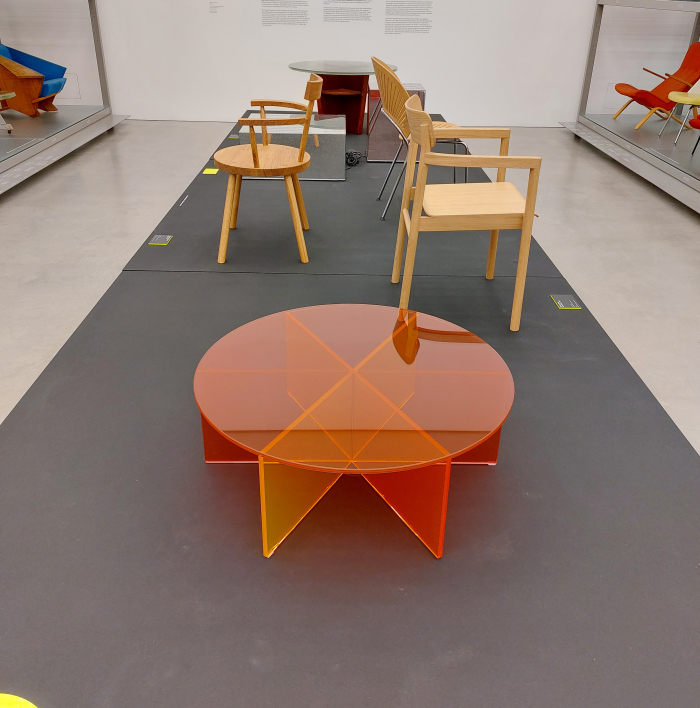
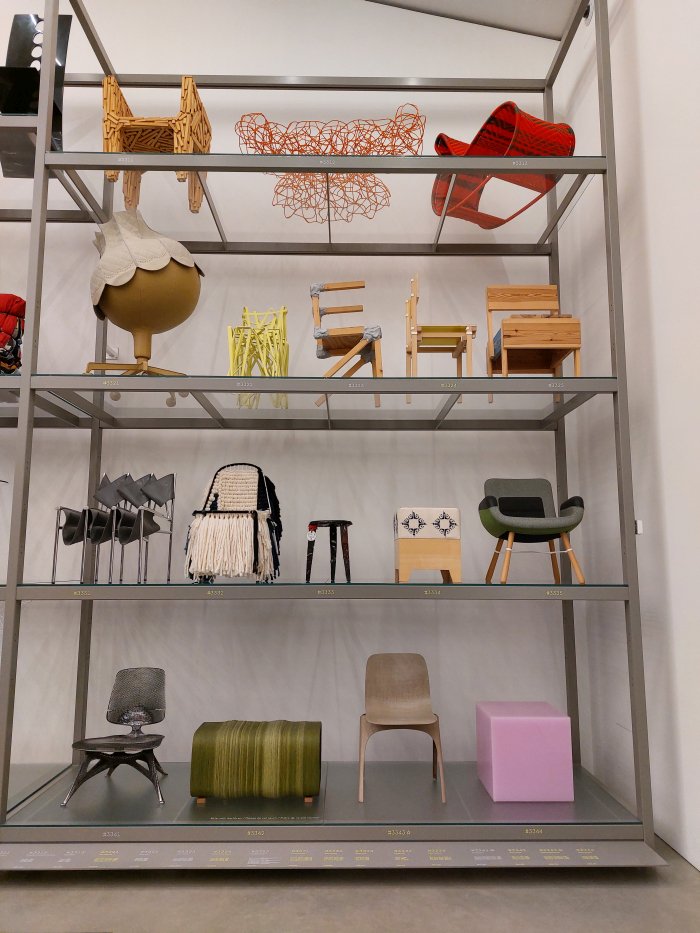
1As ever at this point, we fully accept that gender is but one of the inherent prejudices in the popular (hi)story of (furniture) design that needs to be dismantled, there are others; however, that the subject at hand is gender we therefore discuss in terms of gender. Which isn't to deny the other areas that need to be better documented and more regularly discussed
2Commercial portfolios naturally also often contain works that are interesting, relevant and challenging, but also a lot of commercially driven objects, in many regards a test for the relevance of any given furniture manufacturer is the mix of interesting, relevant and challenging objects and commercially driven objects. We are very much exaggerating the situation here as a rhetorical tool.
3In Göran Schildt, Alvar Aalto. The decisive years (1986) there is a sketch on page 86 for a "sprung version" of the Paimio whose silhouette is even closer to that of Maija-Liisa Komulainen's chair, as is the idea of bringing in resilient seating to a static object. The Aaltos realised the sprung version in the wooden cantilever Armchair 42. While the title of Schildt's book neatly illustrates another part of the problem........
4Yes, and as ever, quality not quantity must be the guiding principle of a meaningful collection, but the numbers also have to be probable and ones that can be defended without relying on Johnsonian logic. And, for example the "Highlights" section of the Vitra Design Museum's online collection is all male, save Ray Eames alongside Charles, Is that probable? 7000 items of furniture from across neigh on 200 years, but the "Highlights" are all by males? Are there no works by females that could be added to that cake?